A local's guide to exploring San Francisco safely and on budget
Like many big cities, San Francisco has endured its share of hardship over the past few years. That much was evident during a four-night stay in the city on a recent California road trip with my boyfriend. It was my first return to the city I once called home in over 25 years and the first-ever visit for my boyfriend.I can easily report The City is alive and well. And despite its doomsaying detractors, it’s also as safe as any other big city if you know where (and where not) to venture.The goal of our visit was to eschew the typical overpriced tourist itinerary and reveal to my boyfriend and other Out Travelers an affordable, safe, and accessible side of San Francisco that few visitors experience.We did this by staying away from high-priced hotels downtown, using transit and rideshares instead of driving, and making use of free activities and events. With a well-fed nod to the culinary delights of the city, we chose to walk whenever possible to burn off extra calories and visit spots missed by those hopping off a tour bus.We devoted full days to each of our three main destinations: Chinatown, North Beach, and the historic waterfront (with a cable car ride); Golden Gate Bridge and the Presidio; and Golden Gate Park and the Castro.How to get thereRather than using our daily subcompact vehicle, we opted to drive a Mitsubishi Outlander PHEV plug-in hybrid SUV for our journey from Palm Springs to San Francisco. It was a decision we did not regret.Our Outlander was powered by a 2.5-liter gas engine and twin electric motors for the front and rear axles. Acceleration was smooth and quick, and there was plenty of horsepower available on demand through mountain passes. The interior was spacious and comfortable with all the appropriate bells and whistles.Despite my concerns with such a large vehicle, gassing and charging the vehicle was an afterthought. We did charge the battery once during the return trip, but only to experience the act. For the rest of the trip we chose the mode that let the Outlander determine when to use and recharge the twin batteries as we drove, and it did a darn good job. On our initial nine-hour drive north from Palm Springs we only refilled our tank before crossing the Bay Bridge into the city, and even then, we had plenty of miles to spare.RELATED: I Drove The Mitsubishi Outlander Plug-in Hybrid & Now I’m In LoveWhere to stayThe Cow Hollow Inn (and its sister properties Chelsea and Coventry Inns) sits on Lombard Street at the nexus of the Marina, Cow Hollow, and Union and Chestnut Street neighborhoods. These are true no-frills properties. There are no gyms, the TVs aren’t smart, and the décor can best be described as Americana spartan. Instead, the Cow Hollow offers oversized rooms and bathrooms kept immaculately clean, comfortable king-sized beds, free WiFi, and free covered parking in San Francisco’s most convenient location. The area is filled with restaurants and shops, and public transit lines safely whisk you to key locations in the city usually in less than 30 minutes. Our room even came with a quintessential San Francisco view.I will also freely admit to a certain sentimentality for the Cow Hollow Inn as I worked there when I was a fresh transplant to San Francisco in the 1980s. I was manning the desk one block away at the sister Chelsea Inn when the Loma Prieta earthquake struck in 1989.How to get around townFor transportation, we made use of Muni, San Francisco’s transit system. Multi-day Visitor Passports give riders unlimited rides on Muni buses, cable cars, historic streetcars, and the Muni Metro subway and above-ground streetcars. Our three-day passport was a bargain at $31, but the seven-day passport for $10 more is an absolute steal. A single-day passport is also available for $13. All passports are available online, on the Muni app, or at ticket kiosks throughout the city.Muni buses and Metro operate on the honor system. Riders need to show a valid ticket only when asked by police or authorized transit employees – there’s no need to show a ticket when boarding.Using the convenient MuniMobile app, we were able to identify simple routes that transported us to our three main destinations (Chinatown, North Beach, and the city’s historic waterfront; Golden Gate Bridge and the Presidio; and Golden Gate Park and the Castro). Each of these destinations was easily reached via a single bus line just outside our hotel.What to do See on Instagram For our first day’s adventure, we left our Mitsubishi Outlander safely secured in the garage and boarded the 30 Stockton bus a short half-block north of the hotel. This line runs every six to 10 minutes during peak hours and passes the Palace of Fine Arts, Fort Mason, Fisherman’s Wharf, Pier 39, and two cable car lines before turning southeast towards the Italian district of North Beach and then south into the heart of historic Chinatown. The line passes through downtown and across Market Street before its terminus. Our passport meant


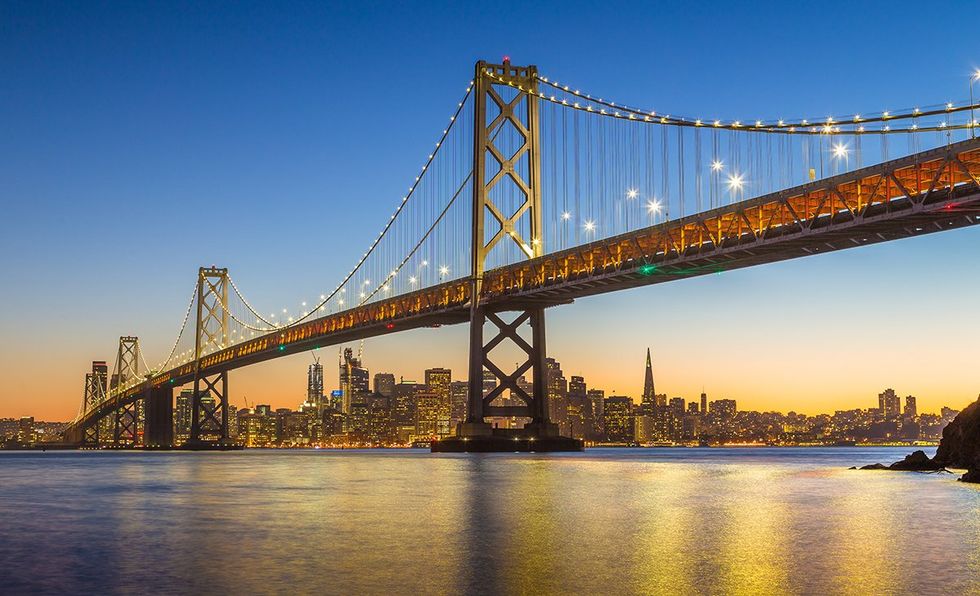
Like many big cities, San Francisco has endured its share of hardship over the past few years. That much was evident during a four-night stay in the city on a recent California road trip with my boyfriend. It was my first return to the city I once called home in over 25 years and the first-ever visit for my boyfriend.
I can easily report The City is alive and well. And despite its doomsaying detractors, it’s also as safe as any other big city if you know where (and where not) to venture.
The goal of our visit was to eschew the typical overpriced tourist itinerary and reveal to my boyfriend and other Out Travelers an affordable, safe, and accessible side of San Francisco that few visitors experience.
We did this by staying away from high-priced hotels downtown, using transit and rideshares instead of driving, and making use of free activities and events. With a well-fed nod to the culinary delights of the city, we chose to walk whenever possible to burn off extra calories and visit spots missed by those hopping off a tour bus.
We devoted full days to each of our three main destinations: Chinatown, North Beach, and the historic waterfront (with a cable car ride); Golden Gate Bridge and the Presidio; and Golden Gate Park and the Castro.
How to get there
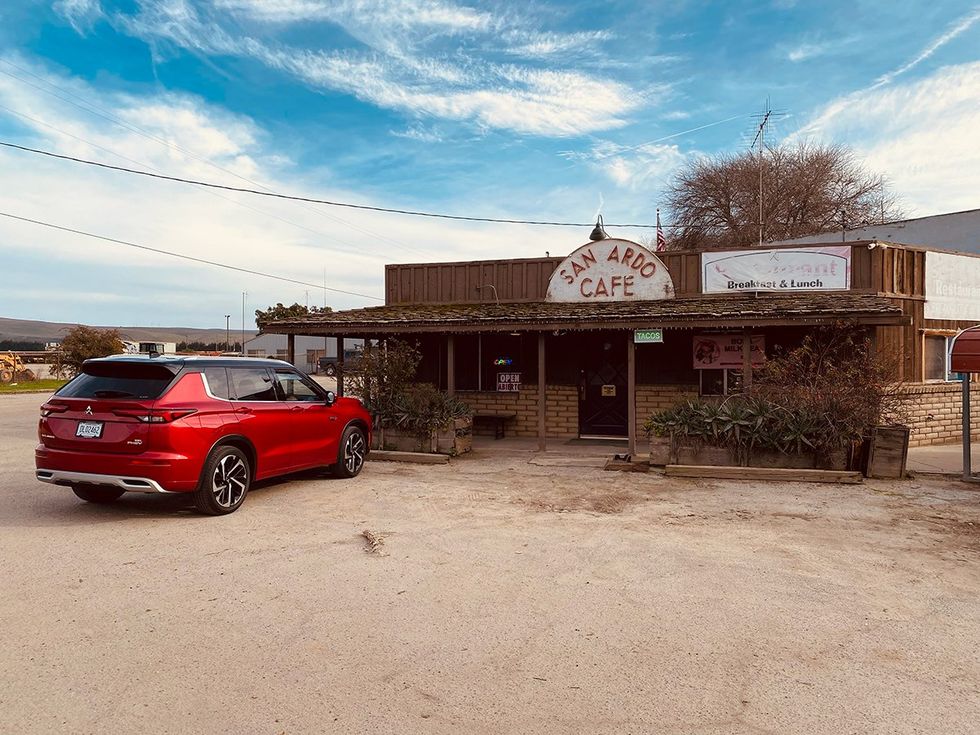
Rather than using our daily subcompact vehicle, we opted to drive a Mitsubishi Outlander PHEV plug-in hybrid SUV for our journey from Palm Springs to San Francisco. It was a decision we did not regret.
Our Outlander was powered by a 2.5-liter gas engine and twin electric motors for the front and rear axles. Acceleration was smooth and quick, and there was plenty of horsepower available on demand through mountain passes. The interior was spacious and comfortable with all the appropriate bells and whistles.
Despite my concerns with such a large vehicle, gassing and charging the vehicle was an afterthought. We did charge the battery once during the return trip, but only to experience the act. For the rest of the trip we chose the mode that let the Outlander determine when to use and recharge the twin batteries as we drove, and it did a darn good job. On our initial nine-hour drive north from Palm Springs we only refilled our tank before crossing the Bay Bridge into the city, and even then, we had plenty of miles to spare.
RELATED: I Drove The Mitsubishi Outlander Plug-in Hybrid & Now I’m In Love
Where to stay
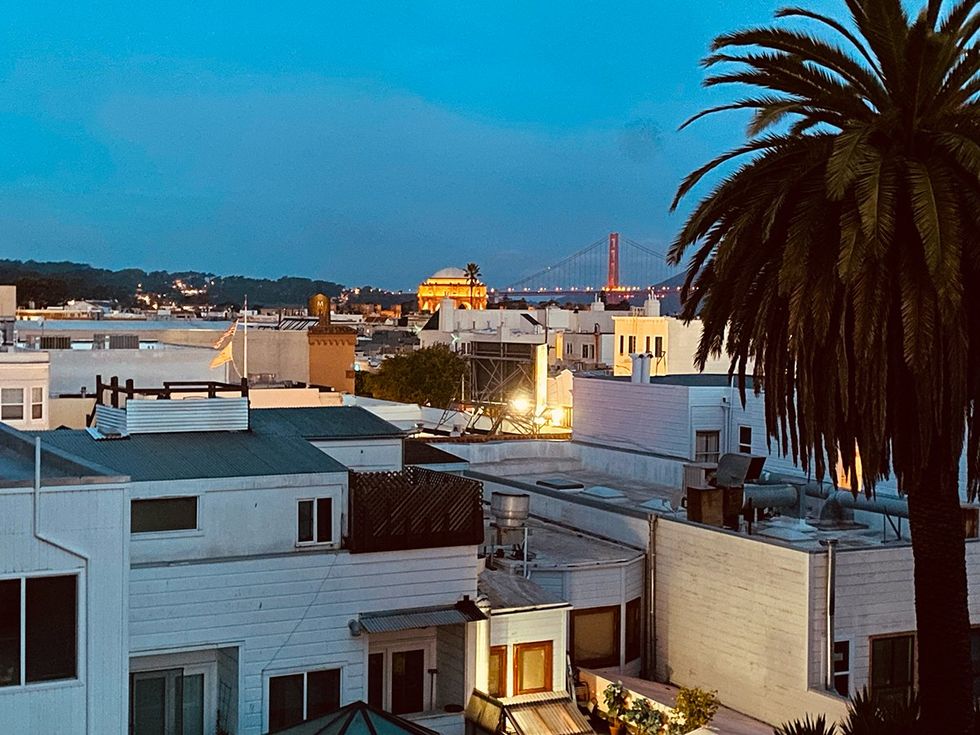
The Cow Hollow Inn (and its sister properties Chelsea and Coventry Inns) sits on Lombard Street at the nexus of the Marina, Cow Hollow, and Union and Chestnut Street neighborhoods. These are true no-frills properties. There are no gyms, the TVs aren’t smart, and the décor can best be described as Americana spartan. Instead, the Cow Hollow offers oversized rooms and bathrooms kept immaculately clean, comfortable king-sized beds, free WiFi, and free covered parking in San Francisco’s most convenient location. The area is filled with restaurants and shops, and public transit lines safely whisk you to key locations in the city usually in less than 30 minutes. Our room even came with a quintessential San Francisco view.
I will also freely admit to a certain sentimentality for the Cow Hollow Inn as I worked there when I was a fresh transplant to San Francisco in the 1980s. I was manning the desk one block away at the sister Chelsea Inn when the Loma Prieta earthquake struck in 1989.
How to get around town
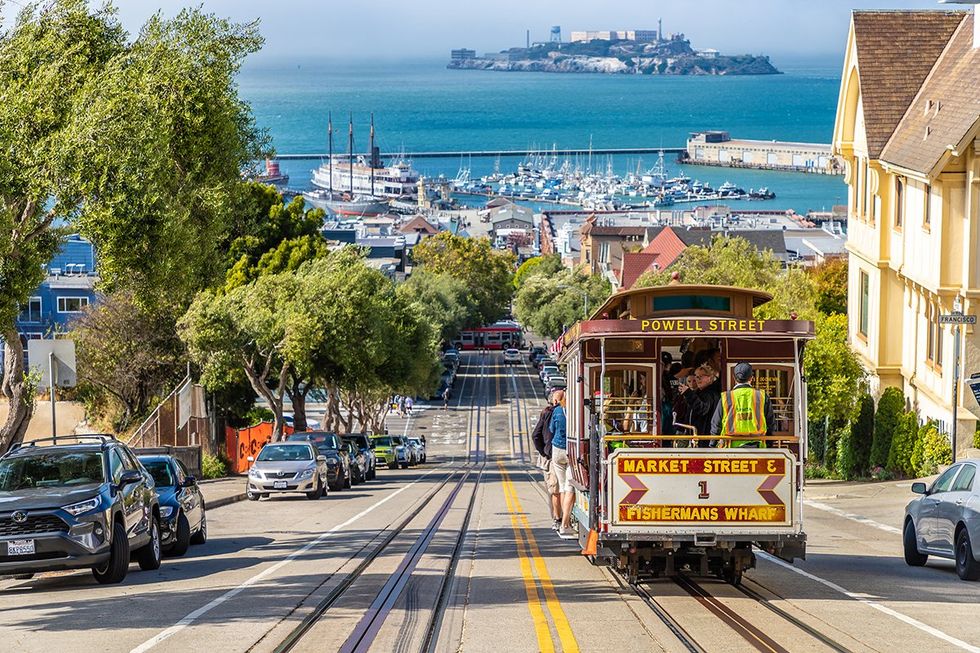
For transportation, we made use of Muni, San Francisco’s transit system. Multi-day Visitor Passports give riders unlimited rides on Muni buses, cable cars, historic streetcars, and the Muni Metro subway and above-ground streetcars. Our three-day passport was a bargain at $31, but the seven-day passport for $10 more is an absolute steal. A single-day passport is also available for $13. All passports are available online, on the Muni app, or at ticket kiosks throughout the city.
Muni buses and Metro operate on the honor system. Riders need to show a valid ticket only when asked by police or authorized transit employees – there’s no need to show a ticket when boarding.
Using the convenient MuniMobile app, we were able to identify simple routes that transported us to our three main destinations (Chinatown, North Beach, and the city’s historic waterfront; Golden Gate Bridge and the Presidio; and Golden Gate Park and the Castro). Each of these destinations was easily reached via a single bus line just outside our hotel.
What to do
For our first day’s adventure, we left our Mitsubishi Outlander safely secured in the garage and boarded the 30 Stockton bus a short half-block north of the hotel. This line runs every six to 10 minutes during peak hours and passes the Palace of Fine Arts, Fort Mason, Fisherman’s Wharf, Pier 39, and two cable car lines before turning southeast towards the Italian district of North Beach and then south into the heart of historic Chinatown. The line passes through downtown and across Market Street before its terminus. Our passport meant we could easily jump off the bus and reboard multiple times as needed.
While undoubtedly touristy, Fisherman’s Wharf boasts the San Francisco Maritime National Historical Park. The park’s historic fleet includes schooners and other vessels from the late 19th century. It’s $15 to see the good stuff up close, but there are no-fee days throughout the year and it’s also possible to appreciate the historic vessels from afar without boarding. Aquatic Park requires no fees and offers great photo opportunities of Alcatraz, the Golden Gate Bridge, and points north.
Neighboring Pier 39 is further to the east. It’s home to a community of sea lions who squatted the slips around the shop and attraction-lined pier following the 1989 Loma Prieta earthquake and never moved out, much to the chagrin of the dock’s original two-legged occupants.
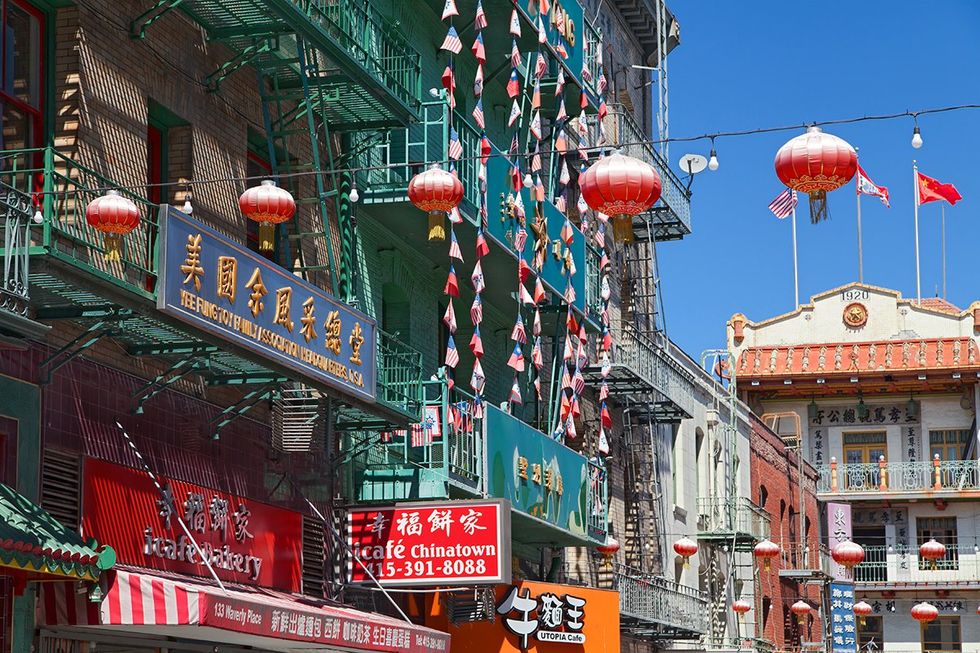
We opted to hop off the bus at the Wharf to catch the Powell/Hyde cable car line. This is the more famous (and popular) of the two lines at the Wharf (the Powell/Mason line is a few blocks east). Both pass through Chinatown and end on Market and Powell streets downtown. The Powell/Hyde is the only line to pass the historic crooked section of Lombard Street.
We hopped off the cable car on Washington Street in Chinatown and immediately set out for Waverly Place. It’s the second oldest alley in Chinatown and is considered by many to be the neighborhood’s historic heart. The alley is alive with colorful banners and decorations, and the multi-storied historic buildings feature nerve-rattling balconies and hidden surprises like the Tin How Temple, the oldest surviving Taoist Temple in San Francisco. First founded in 1852, it has been at its current upstairs location at 125 Waverly Place since its original home was destroyed in the 1906 earthquake and fire.
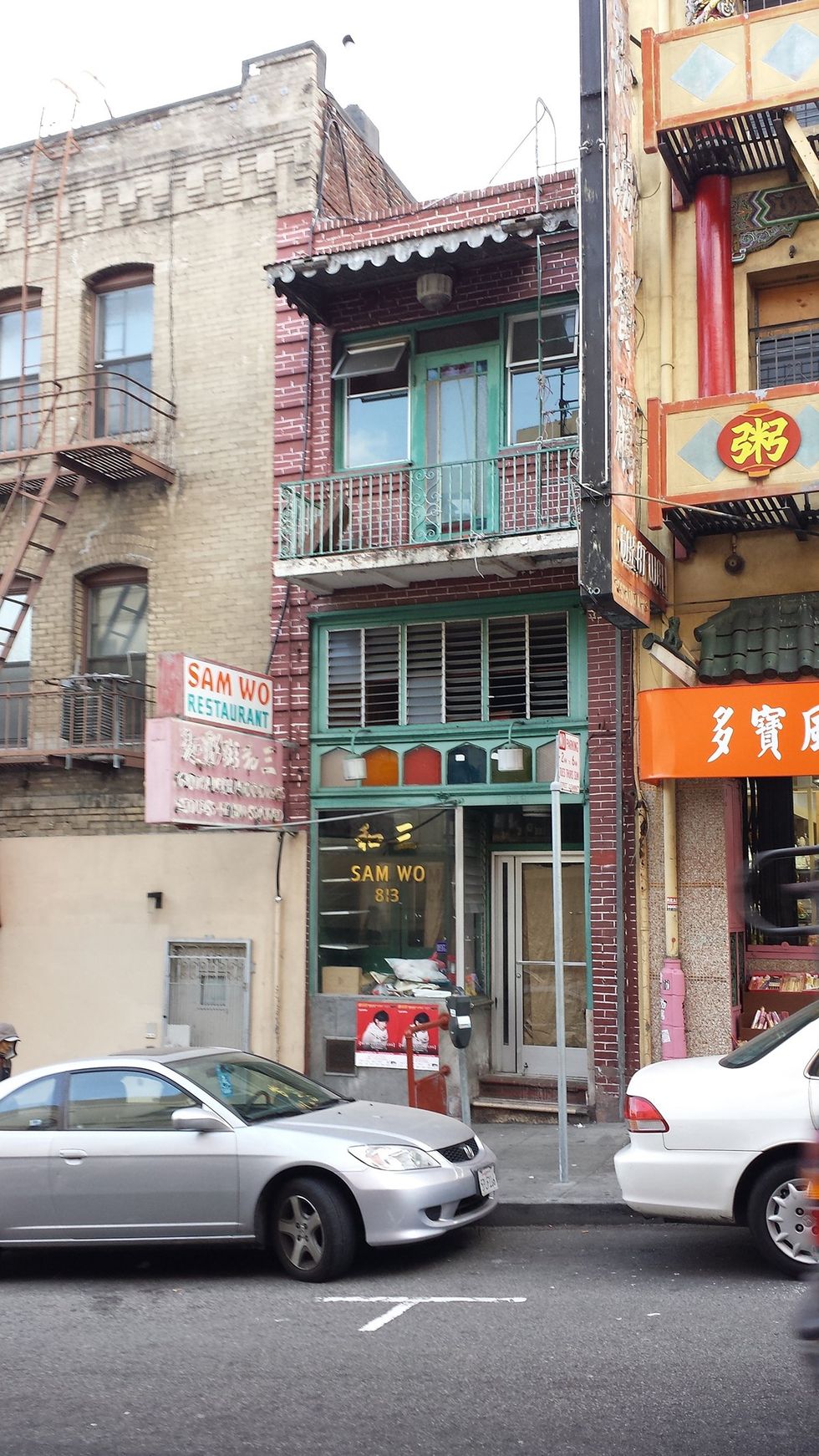
For those not necessarily on a budget, Waverly Place is also home to the Michelin-starred Mister Jiu’s restaurant featuring contemporary American Chinese cuisine. In a nod to our budget and many inebriated late-night visits during my younger days, however, we dined for lunch at the equally renowned Sam Wo Restaurant.
This historic restaurant’s simple and inexpensive fare has fed everyone from local laborers in the early 20th century to beatniks like Allen Ginsburg and Charles Bukowski. Its original Washington Street location closed in 2012, but the family reopened in a strikingly similar building a block away on Clay Street. Gone also is Edsel Ford Fung, the notoriously surly server lovingly known to locals as the world’s rudest waiter. You still walk through the kitchen and sit on low benches and tables upstairs though, and the food is hearty and no-frills as ever.
After lunch, we explored the shops along Grant Street and visited the free San Francisco Cable Car Museum. From there we walked east along Washington Street past the iconic Transamerica Pyramid and into the historic Barbary Coast district. The area is now filled with modern high-rises, but it used to be the original waterfront of the city and is a graveyard for abandoned ships and piers underneath the district’s buildings and streets.
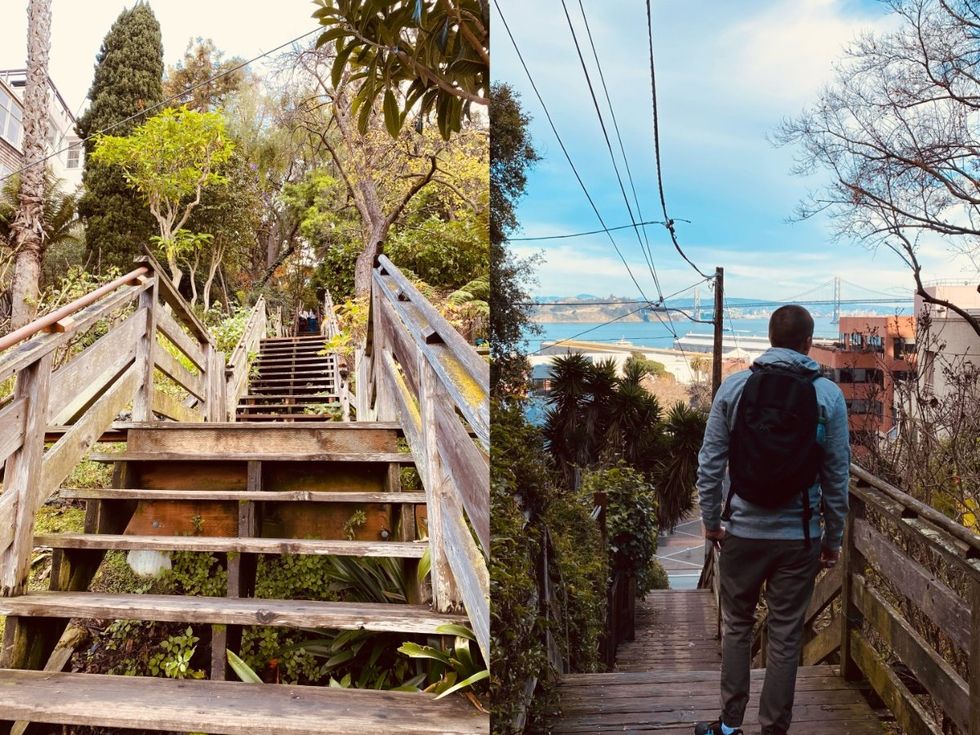
We avoided the boisterous skateboarding crowd at the Embarcadero Plaza (although the Ferry Building Marketplace is worth a visit) and instead turned north on Battery Street until we reached Filbert Street and the famed Filbert Street Steps climbing Telegraph Hill to Coit Tower.
For those with a minimum of physical conditioning, the Filbert Stairs should not present a challenge. Those with a fear of heights, however, might want to take an alternate route to the top. The first few flights are a rickety collection of exposed stairs attached to the side of an unnervingly tall retaining wall. Beyond that, however, the stairs become far more serene, surrounded by quaint (but expensive) homes and gardens. There’s even a flock of liberated parrots (profiled in the PBS documentary The Wild Parrots of Telegraph Hill). Those who ventured this far are rewarded for their efforts with outstanding views of the waterfront, Bay Bridge, Oakland, and the surrounding communities to the east.
After a brief stop to admire the windswept views from Coit Tower, we descended west into North Beach. We stopped for some sweets at Stella Bakery on Columbus Avenue before sampling authentic cioppino at Sotto Mare. We then hopped on the 45 Union bus which took us back to the Cow Hollow neighborhood. We could have retraced our morning route on the 30 Stockton, but the 45 Union was a more direct route from our current location and took us through the Union Street neighborhood of restaurants and shops.
We later ordered takeout from Phat Thai restaurant next door to our hotel, then rested up for day two of our San Francisco adventure on a budget: a trip to the Golden Gate Bridge and the historic Presidio.

 Mark
Mark 





